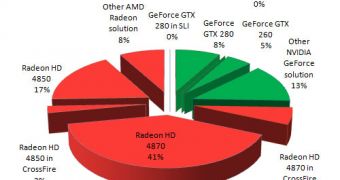Although Nvidia is working hard on making its graphics cards strong competitors for the latest Radeon 4800 series released by AMD, some poll results published by HEXUS.community show thet GeForce 260 and 280 are far low in people's preferences. The answers to a question launched about two weeks ago revealed that 74 percent of the community members would rather go for an AMD graphics card.
Users were asked to choose from ten graphics boards, five Nvidia based, GeForce GTX 280 in SLI, GeForce GTX 280, GeForce GTX 260 in SLI, GeForce GTX 260, among them, and five AMD based, Radeon HD 4870 in CrossFire, Radeon HD 4870, Radeon HD 4850 in CrossFire, Radeon HD 4850, among them.
The poll results show as a detached leader the top-of-the-range Radeon HD 4870, with a 47% "share". Following behind, the mid-range Radeon 4850 board would be the choice of 19% users. These results show that AMD's latest launched 4800 series graphics cards leads in users' preferences top.
Surprisingly enough, far less users would choose an Nvidia based board for their future graphics solution. Although said to be the fastest single-GPU in the world, NVIDIA's GeForce GTX 280 appealed only to eight percent of the users. Next on Nvidia front, the GeForce GTX 260 would interest five percent of the users. Surprisingly, 13 percent made an option on other NVIDIA GeForce-based solution, but we may put that on the account of price differences.
Another interesting fact is that CrossFire and SLI options still remain far behind in the top of preferences. Only eight percent would have the CrossFire setup as an option on their computer, while Nvidia's SLI represents no interest for users.
Both AMD and Nvidia should consider these results for their future planning, including the designing of their next graphics cards and setting the price tags. Nvidia should be more concerned, since the company is experiencing a lot of problems lately, with faulty chips, stock price drop and less than expected Q2 revenues.

 14 DAY TRIAL //
14 DAY TRIAL //